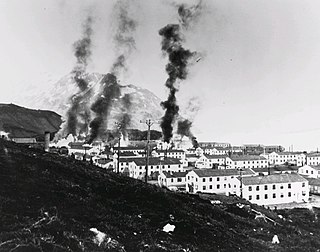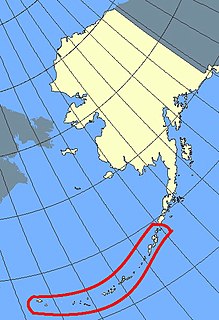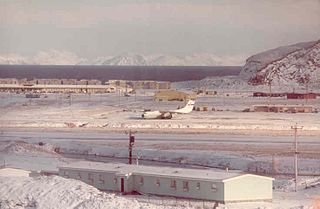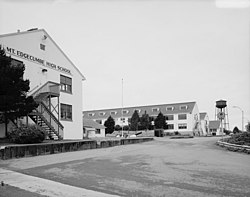
Sitka is a unified city-borough in the southeast portion of the U.S. state of Alaska. It was formerly known as New Archangel while under Russian rule from 1799 to 1867. The city is situated on the west side of Baranof Island and the south half of Chichagof Island in the Alexander Archipelago of the Pacific Ocean. As of the 2020 census, Sitka had a population of 8,458, the fourth-most populated city in the state.

Attu is an island in the Near Islands. It is the westernmost point of the U.S. state of Alaska. The island became uninhabited in 2010, making it the largest uninhabited island to be politically part of United States.

Simon Bolivar Buckner Jr. was a lieutenant general in the United States Army during World War II who served in the Pacific Theater. As commanding general of Alaska Defense Command, Buckner commanded American-Canadian forces in the Aleutian Islands campaign, including the Battle of Attu and the Kiska Expedition. Following that assignment, he was promoted to command the Tenth Army, which conducted the amphibious invasion of the Japanese island of Okinawa in 1945. He was killed during the closing days of the Battle of Okinawa by enemy artillery fire, making him the highest-ranking United States military officer lost to enemy fire during World War II.
Adak Island or Father Island is an island near the western extent of the Andreanof Islands group of the Aleutian Islands in Alaska. Alaska's southernmost town, Adak, is located on the island. The island has a land area of 274.59 square miles (711.18 km2), measuring 33.9 miles (54.5 km) long and 22 miles (35 km) wide, making it the 25th largest island in the United States.

The Aleutian Islands campaign was a military campaign conducted by the United States, Canada, and Japan in the Aleutian Islands, part of the Territory of Alaska, in the American Theater and the Pacific Theater of World War II starting on June 3, 1942. In the only two invasions of the United States during the war of a U.S. incorporated territory, a small Japanese force occupied the islands of Attu and Kiska, where the remoteness of the islands and the challenges of weather and terrain delayed a larger American-Canadian force sent to eject them for nearly a year. Successful Japanese invasions of other U.S. territories, which were unincorporated territories, in the western Pacific shortly after the Attack on Pearl Harbor included Wake Island, Guam, and the Philippines. The islands' strategic value was their ability to control Pacific transportation routes as US General Billy Mitchell stated to the U.S. Congress in 1935, "I believe that in the future, whoever holds Alaska will hold the world. I think it is the most important strategic place in the world."

The Eleventh Air Force (11 AF) is a Numbered Air Force of the United States Air Force Pacific Air Forces (PACAF). It is headquartered at Joint Base Elmendorf–Richardson, Alaska.

Sitka Rocky Gutierrez Airport is a state-owned, public-use airport located west of the central business district of Sitka, a city and borough in the U.S. state of Alaska.
Montauk Air Force Station was a US military base at Montauk Point on the eastern tip of Long Island, New York. It was decommissioned in 1981 and is now owned by the New York State Office of Parks, Recreation and Historic Preservation as Camp Hero State Park.
The Aleutian World War II National Historic Area is a U.S. National Historic Site on Amaknak Island in the Aleutian Island Chain of Alaska. It offers visitors a glimpse of both natural and cultural history, and traces the historic footprints of the U.S. Army Base, Fort Schwatka, located at the Ulakta Head on Mount Ballyhoo. The fort, 800 miles west of Anchorage, the nearest large urban center, was one of four coastal defense posts built to protect Dutch Harbor during World War II; Fort Schwatka is also the highest coastal battery ever constructed in the United States. The other Army coastal defense facilities were Fort Mears, Fort Learnard, and Fort Brumback. Engineers designed the concrete observation posts and command stations to withstand earthquakes and 100 mph winds. Although today, many of the bunkers and wooden structures of Fort Schwatka have collapsed, the gun mounts and lookouts are among the most intact in the country.

The Battle of Dutch Harbor took place on June 3–4, 1942, when the Imperial Japanese Navy launched two aircraft carrier raids on the Dutch Harbor Naval Operating Base and U.S. Army Fort Mears at Dutch Harbor on Amaknak Island, during the Aleutian Islands Campaign of World War II. The bombing marked the first aerial attack by an enemy on the continental United States, and was the second time in history that the continental U.S. was bombed by someone working for a foreign power, the first being the accidental bombing of Naco, Arizona in 1929.

Cape Field at Fort Glenn was a military site significant for its role in World War II. It consists of Fort Glenn, an airfield of the United States Army Air Corps later renamed Cape Air Force Base, and the adjacent Naval Air Facility Otter Point, both located on Umnak Island in the Aleutian Islands of southwestern Alaska. The site was listed on the National Register of Historic Places and declared a National Historic Landmark in 1987.

The Japanese occupation of Kiska took place between 6 June 1942 and 28 July 1943 during the Aleutian Islands Campaign of the American Theater and the Pacific Theater of World War II. The Japanese occupied Kiska and nearby Attu Island in order to protect the northern flank of the Japanese Empire. Along with the Attu landing the next day, it was the first time that the United States was occupied by a foreign power since the War of 1812, and was one of the two invasions of the United States during World War II.

The Dutch Harbor Naval Operating Base and Fort Mears were the two military installations built next to each other in Dutch Harbor, on Amaknak Island of the Aleutian Islands in Alaska, by the United States in response to the growing war threat with Imperial Japan during World War II. In 1938, the Navy Board recommended the construction which began in July 1940. The first United States Army troops arrived in June 1941 and an air base constructed by the United States Navy was finished in September 1941. At the time of the surprise attack on Pearl Harbor, these were the only military installations in the Aleutian Islands.

The Japanese Occupation Site on Kiska island in the Rat Islands group of the Aleutian Islands of Alaska is where the Imperial Japanese Navy attacked and occupied the island in World War II, as one of the only two enemy invasion sites in North America during the war. The Japanese built defenses and other infrastructure on the island before abandoning it in 1943 after losing the Battle of Attu. American and Canadian forces reoccupied the abandoned island, and departed the island in 1946. Now a part of the Alaska Maritime National Wildlife Refuge, the central portion of the island, where these military activities were concentrated, was designated a National Historic Landmark in 1985.

The Japanese occupation of Attu was the result of an invasion of the Aleutian Islands in Alaska during World War II. Imperial Japanese Army troops landed on 7 June 1942 the day after the invasion of Kiska. The invasions on Attu Island and Kiska were conducted under the AL operation in the Japanese military. Along with the Kiska landing, it was the first time that the continental United States was invaded and occupied by a foreign power since the War of 1812, and was the second of the only two invasions of the United States during World War II. The occupation ended with the Allied victory in the Battle of Attu on 30 May 1943.

The military history of the Aleutian Islands began almost immediately following the purchase of Alaska from the Russian Empire by the United States in 1867. Prior to the early 20th century, the Aleutian Islands were essentially ignored by the United States Armed Forces, although the islands played a small role in the Bering Sea Arbitration when a number of British and American vessels were stationed at Unalaska to enforce the arbitrators' decision. By the early 20th century, a number of war strategies examined the possibility of conflict breaking out between the Empire of Japan and the United States. While the Aleutian Islands were seen as a potential staging point for invasions by either side, this possibility was dismissed owing to the islands' dismal climate. In 1922, the Washington Naval Treaty was signed, after which the United States Navy began to take an interest in the islands. However, nothing of significance was to materialize until World War II.
Cape Air Force Base also known as Fort Glenn Army Air Base, is a site significant for its role in World War II fighting, operating alongside Naval Air Facility Otter Point.

Naval Air Facility Adak, was a United States Navy airport located west of Adak, on Adak Island in the U.S. state of Alaska. After its closure in 1997, it was reopened as Adak Airport. The facility was designated a National Historic Landmark for its role in World War II, although most of its elements from that period have been demolished or lie in ruins.
VP-3 was a Patrol Squadron of the U.S. Navy. The squadron was established as Patrol Squadron 16-F (VP-16F) on 2 January 1937, redesignated Patrol Squadron 16 (VP-16) on 1 October 1937, redesignated Patrol Squadron 41 (VP-41) on 1 July 1939, redesignated Bombing Squadron 136 (VB-136) on 1 March 1943, redesignated Patrol Bombing Squadron 136 (VPB-136) on 1 October 1944, redesignated Patrol Squadron 136 (VP-136) on 15 May 1946, redesignated Medium Patrol Squadron (landplane) 3 (VP-ML-3) on 15 November 1946, redesignated Patrol Squadron 3 (VP-3) on 1 September 1948, and was disestablished on 1 November 1955. It was the second squadron to be designated VP-3, the first VP-3 was redesignated VP-32 on 1 July 1939.

Patrol Bombing Squadron 61 (VPB-61) was a maritime patrol squadron of the United States Navy, in service from 1942 to 1945.


















